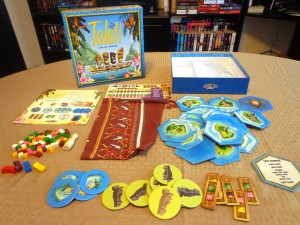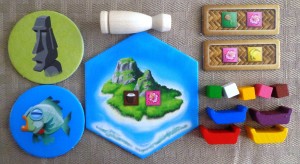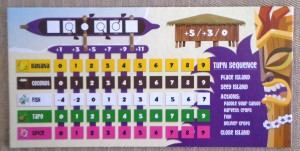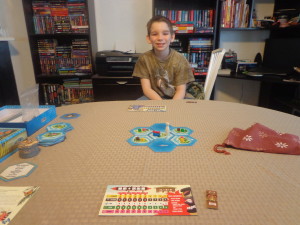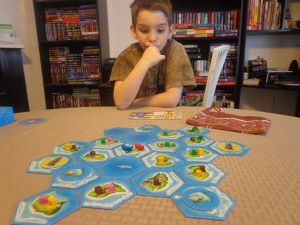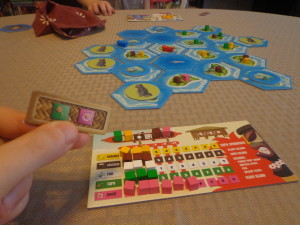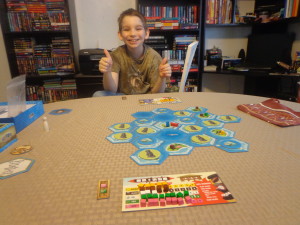“Tahiti” is a resource gathering game that tasks players with collecting the most goods for their respective tribe. The game starts players out on a small group of islands, but through tile placement, players will be expanding the archipelago (an island group or chain) in an attempt to control what type of resources spawn where. Will you have what it takes to ensure that your tribe has the most resources by the end of it all? Before we take a look at this game in further detail, I’d like to thank James Mathe from Minion Games for providing me with a free review copy.
Components
Tiles – There are a total of twenty-two tiles, consisting of one home island tile, eighteen island tiles, and three water tiles. Tiles spawn resources and act as the playing field in which players will be moving around.
Player Boards – Each player receives a player board, which allows them to keep track of the resources they’ve collected and scored in their travels.
Canoes – Each player receives a canoe, which they’ll use to move around the tiles and collect resources.
Goods Cubes – There are eighty goods cubes, sixteen of each type. Players will be attempting to collect and score these resources in order to win the game.
Haumea Pawn – There is one Haumea pawn, which represents the goddess of fertility. This pawn plays an important role during tile placement.
Favorite Crops Tiles – There are seven favorite crops tiles that are used to determine bonuses during endgame scoring. Each tile has two goods listed on it.
Depletion Tokens – These eighteen depletion tokens are played near the end of the game, on islands that have no goods on them. Some tokens provide a bonus to fishing, which increases the chance a player might catch a fish.
Drawstring Bag – Players will be drawing goods cubes from the drawstring bag when appropriate during the game.
Game Setup
*The home island tile is placed in the center of the table and is flipped to the appropriate side depending on how many people are playing the game.
*Players will seed the area surrounding the home island tile with the appropriate matching tiles. The way this is done again depends on how many people are playing.
*Goods are seeded on the starting island tiles, the colors of the goods placed matching the colors on the islands. The rest of the goods cubes are placed into the bag. It’s important to note that not all of the cubes may be used in the game, depending on how many people are playing.
*The Haumea pawn and player canoes are placed on the home island tile.
*Each player receives a player board and a favorite crops tile, the latter of which they’ll keep secret throughout the game.
*The depletion tokens are mixed up, face down and the island tiles are shuffled and placed face up into two equal stacks.
*Players choose a starting player, assuming that no one can figure out who paddled a canoe last.
Gameplay
The game is played over a series of rounds and in each round, every player takes one turn going clockwise. During a player turn, a player will complete the following phases in this order:
1. Exploration Phase: The player must move the Haumea pawn towards the edge of the board. If it is already on the edge of the playing area, the player has the option to move it. The pawn moves one space in any direction, following the above rule, and must be at an edge after movement takes place. After that, the player takes one of the island tiles from the two stacks and places it so that it is adjacent to the pawn and two other tiles. Once the island tiles run out, the pawn is removed from the game and this phase is skipped.
2. Haumea’s Bounty Phase: First, the player must draw goods cubes from the bag (three if Haumea is in play, two if not) and place them on matching island tile spaces, if possible. Goods can’t be placed on islands with depletion tiles. Goods that can’t be placed go back into the bag.
3. Action Phase: The number of actions a player can take depends on how many canoe rower spaces are filled up by goods cubes on their player board. The more rowers that are available (not replaced by cubes), the more actions a player can take. A player can paddle their canoe, harvest goods, go fishing, and deliver goods. Actions can be repeated and be done in any order. The rules for each action are too lengthy to go into here, but suffice it to say that players will be trying to collect goods from various tiles and bring them back to the home island tile for delivery. Goods that are delivered in this way go onto a player’s board permanently for endgame scoring.
4. Depletion Phase: This phase is skipped if the Haumea pawn is still on the board. Otherwise, the player will place a random depletion token on the empty island tile of their choice. Islands marked this way don’t produce goods for the rest of the game, though some depletion tokens give bonuses to the fishing action.
Players continue to take turns until there are only four island tiles not marked with a depletion token. Once that event occurs, players take turns normally until the end of the round (so that all players have an equal number of turns). After that, players total up their scores, taking into account all of the bonuses that the game allows. The person that scored the most points wins the game.
The above is simply an overview and doesn’t cover all of the rules found in the manual, but should give you an idea of what the game is like. For more information, you can view the manual and a helpful tutorial video, here:
http://www.miniongames.com/rules/Tahiti_Rules.pdf
http://www.youtube.com/watch?feature=player_embedded&v=C0hHJXzrtVg
The Review
The game components were sturdy and I had no trouble making out the various colors on the island tiles. Vinnie (11) and I enjoyed the art on the player boards and island tiles. The learning curve wasn’t too bad, though I had to read the manual a few times to understand how all of the game’s mechanics came together. While the game is easy to moderate in terms of difficulty, there’s a lot to consider during the many phases of the game. I can see where a new or casual player might be intimidated at first, though in most cases I can see that being overcome after the first few rounds of play. Once players get into the swing of things, they’ll be able to concentrate more on the strategy as opposed to how the game mechanics function.
While the general idea behind the game is simple, there’s a lot to think about during a player’s turn. Which actions are the best to take right now? Should I load up my canoe to its full capacity (covering up rowers) and limit the number of actions I have on future turns until I unload the goods I’ve collected? Do I take the chance of going over a reef and possibly losing some or all of the goods I have in my canoe? Which direction should I move the Haumea pawn so that it would benefit me most? Should I collect resources of one type or should I collect one of each, as per the “harvest goods” rule? Players will be asking themselves these questions as they play, opening up the door for many different types of strategies to unfold. Just to name an example, some might keep their canoe at a lighter load to ensure that they can take three or four actions a turn while others might take the viewpoint that the more they load onto their canoe, the better.
Scoring is another big factor in the way a player will develop his or her strategy. The favorite crops tile a player receives will tell them which goods will provide them with bonus points at the end of the game, should they get the most or second most of the goods in question. This might encourage players to pass up certain opportunities in favor of collecting the goods they’d need to ensure that they had the most. Players also score based on the number of goods they’ve collected of a particular type and score based on the number of complete sets they’ve managed to make. Since goods are plentiful early to mid-game and are rare toward the endgame (with the exception of fish, depending on the situation), there’s a bit of tension going on as players rush to score the particular goods that they may need to receive those bonuses.
Vinnie had a fun time moving around and collecting resources. It took him a few rounds to fully understand how the game came together but once he did, he was quickly on his way to giving thought as to how to collecting resources of a particular type for scoring purposes. Watching him collect resources this way allowed me to guess as to what was on his hidden favorite crops tile, which opened the door for possible sniping…that is, going after those resources yourself to prevent someone else from getting them. I keep that kind of sneakiness to a minimum for the benefit of the kids, but other groups may exploit that mechanic to its fullest via bluffing and etc. If your group is a bit more hardcore, then prepare to have your wits and poker face ready.
Overall, I found “Tahiti” to be a fun and engaging game. There are many ways to play the game in order to score points, and your strategies will change based on the layout of the board. This feature alone gives the game almost unlimited replayability. With the proper parental guidance, younger children will have the ability to play it too. There are a lot of little pieces, so keep pets and toddlers away, if it all possible. The game is currently being sold in various places for prices in the twenty dollar range (as of 3/6/13), which I believe is a fair price all things considered. If you’re looking for a good, light-hearted game to play on family game night, then “Tahiti” will fit the bill nicely.
Final Verdict: 8/10
—
You can learn more about and purchase “Tahiti” by visiting the following websites:
http://boardgamegeek.com/boardgame/118776/tahiti

